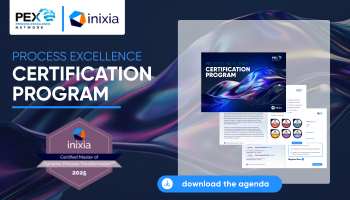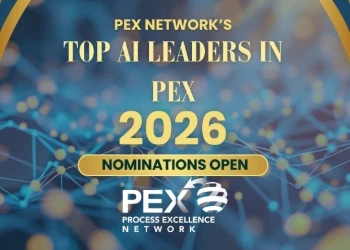Operationalizing responsible AI through process governance
Responsible AI is a process excellence discipline that demands the same rigor as quality, risk, and compliance programs
Add bookmark
Artificial intelligence (AI) adoption is accelerating, but governance has not kept pace. In highly regulated industries like healthcare, insurance, and manufacturing, organizations face a recurring dilemma: how to scale AI responsibly while maintaining compliance and public trust.
The solution lies not in more algorithms but in governed intelligence, where AI operates within a defined process framework. Responsible AI is no longer just an innovation challenge; it is a process excellence discipline that demands the same rigor as quality, risk, and compliance programs.
Join the PEX Network community

Don't miss any news, updates or insider tips from PEX Network by getting them delivered to your inbox. Sign up to our newsletter and join our community of experts.
Learn MoreWhy AI needs process governance
According to McKinsey’s State of AI, 55 percent of executives cite governance as the top obstacle to scaling AI. The issue is not technology but accountability.
AI systems often make or influence decisions about patient care, policy approvals, or financial outcomes. Without governance, these systems become opaque, bias creeps in undetected, and regulatory audits turn reactive.
Applying process excellence principles such as Lean Six Sigma provides stability. Clear ownership, standardized workflows, and measurable indicators turn AI from an experimental capability into a controlled business process. Governance doesn’t slow innovation, it sustains it.
Designing a responsible AI operating model
A practical operating model for responsible AI includes four integrated layers:
- Data integrity: Define lineage, quality thresholds, and classification policies using enterprise data catalogs such as Microsoft Purview or Informatica Axon.
- Model governance: Establish version control, testing protocols, and approval gates for model lifecycle management.
- Operational controls: Deploy monitoring dashboards that measure bias, fairness, drift, and explainability in production.
- Human oversight: Maintain human-in-the-loop reviews for decisions that carry ethical or regulatory weight.
This model converts abstract ethical commitments into repeatable operational routines that are auditable, transparent, and adaptable across functions.
Lessons from regulated industries
Healthcare
A US healthcare network deployed AI to predict patient therapy adherence. Governance dashboards tracked each model decision, reducing compliance exceptions by 30 percent and improving outreach precision by 20 percent.
Insurance
An insurer implemented AI underwriting with quarterly governance reviews. By embedding explainability tools and bias checks, approval times fell by 40 percent while maintaining full audit readiness.
Manufacturing
A global materials company integrated defect detection AI into its process control system with real-time oversight. Scrap dropped by 20 percent while maintaining ISO 9001 and FDA audit compliance.
These cases show how governance transforms AI from a black box into a business performance engine.
Building cross-functional accountability
Responsible AI cannot rest with data scientists alone. True governance demands shared accountability across IT, compliance, and business operations. Successful programs create:
- AI steering committees including data, risk, legal, and transformation leaders.
- RACI frameworks clarifying ownership for data, models, and deployment.
- Transparent incentive systems where KPIs reward reliability and ethics, not just speed.
Culture is the ultimate differentiator. Organizations that treat transparency and ethics as productivity enablers build more resilient AI systems and stronger reputations.
Leadership imperatives for 2025 and beyond
The rise of responsible AI is redefining how COOs, CIOs, and CDOs lead. Governance must be embedded into strategic scorecards. This includes linking AI ethics goals to operational KPIs, board reviews, and continuous improvement cycles.
In my experience leading AI-enabled transformation programs across regulated enterprises, governance succeeds when it is viewed not as compliance overhead but as a leadership capability. Future-ready organizations are investing in ‘digital quality offices’ that unite process excellence, data governance, and AI engineering under one charter of trust.
Measuring maturity and ROI
Governance maturity should be quantifiable. Leading enterprises track:
- Model audit completion rate.
- Bias index variance across protected groups.
- Data quality compliance rate.
- Incident response time for model issues.
- Business outcomes: Efficiency gains, risk mitigation, or customer engagement.
The road ahead
AI governance is entering the same maturity curve once seen with ISO 9001 and ITIL. Over the next decade, AI and process excellence will converge into standardized frameworks. Responsible AI will become a management system complete with audits, controls, and improvement cycles.
Organizations that operationalize governance today will gain lasting advantage. The leaders of tomorrow will not be those deploying the most AI models, but those running the most accountable models that perform consistently, ethically, and transparently at scale.
Key takeaways
- Governance is process, not policy: Treat responsible AI as a managed business capability.
- Cross-functional ownership is essential: Accountability must span IT, compliance, and operations.
- Culture drives compliance: Transparency and ethics should be rewarded as performance multipliers.
- Process excellence and AI will converge: Expect responsible AI to become a recognized enterprise standard by 2028.
Professional Process Excellence Certification Provided by Inixia in Partnership with PEX Network

Designed for today’s fast-paced, competitive business landscape, this certification signals a deep capability in operational excellence and innovation. It enables professionals to lead process transformation across functions and industries, and become change agents within their organizations. Whether you're advancing your career or strengthening your team’s performance, the Certified Master of Dynamic Process Transformation provides a forward-thinking, results-driven approach to creating sustainable value and long-term success.
Learn More















